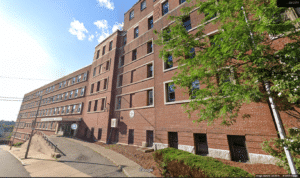A Catholic social service agency and the Archdiocese of Boston’s affordable housing development arm are proposing to renovate and expand a Dorchester former hospital that houses families trying to escape homelessness.
St. Mary’s Center for Women and Children and the Planning Office of Urban Affairs told Boston planning officials in a letter that they intend to renovate the former St. Mary’s Hospital at 90 Cushing Ave. in Dorchester’s Jones Hill section and replace its “literally crumbling” parking garage. The campus currently hosts educational and job training programs for the “more than 500 mothers, fathers and children” that St. Mary’s Center serves at the site and its East Boston location, plus 12 housing units that are part of the St. Mary’s Center family shelter program.
A two-phase redevelopment of the site is planned, according to a notification letter St. Mary’s Center and POUA filed with the Boston Planning & Development Agency Sept. 5.
First, the hospital buildings will be renovated using city, state and private dollars to convert it into “de-densified, dignified living space” for mothers and children experiencing homelessness made up of two- to four-bedroom apartments organized in “open pods.”
Next, the existing family shelter units will be demolished, along with the parking garage on site, and 71 two- and three-bedroom apartments aimed at households earning 30 percent of the Boston area median income or less who have experienced homelessness. The units will offer an “off-ramp” to independent living for families St. Mary’s Center currently serves, the letter said, along with families in similar situations. This new apartment building will also have a 71-space underground garage, a bicycle storage room and a multipurpose common room.
Both the hospital renovation and the new apartment building will be designed to be LEED Gold-certifiable, the letter said. A preliminary site plan filed with the letter also showed a playground and renovated outdoor courtyard.
Both phases, taken together, will let St. Mary’s Center serve 30 percent more people, the letter added.







